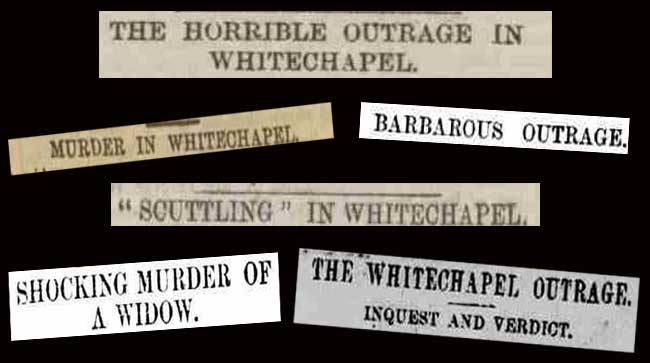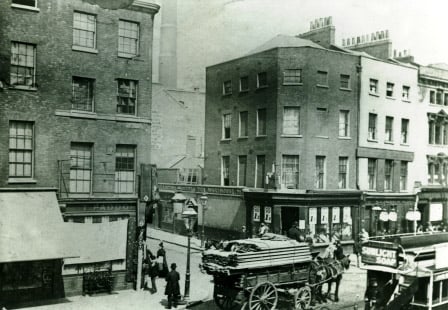Today sees the anniversary of an attack in 1888 which became the first of the Whitechapel Murders.
The crime in question was almost certainly not carried out by the murderer who became known as Jack the Ripper, but it is safe to say that it did cause outrage, not just in the East End of London but throughout the country a a whole, as can be gleaned from the following newspaper headlines.

THE WHITECHAPEL OUTRAGE
Early in the evening of the bank holiday Monday, April 2nd 1888, Emma Elizabeth Smith, whom newspaper reports described as a “widow”, had left the lodging house at 18 George Street, where she had been living for the previous 18 months, intending to raise some money through prostitution.
Her movements throughout the rest of the evening were somewhat sketchy, although a woman later testified that she had seen her in the early hours of Tuesday April 3rd in the vicinity of Burdett Road chatting with a man dressed in dark clothing who sported a white neckerchief.
The woman testified that there had been some “rough work” going on in the neighbourhood that night and recounted that she herself had been assaulted by two men just before seeing Emma Smith, albeit she also stated that the man talking to Smith was not one of the men who had attacked her.
EMMA ARRIVES HOME
The next ascertained sighting of Emma Smith was between four and five in the morning of April 3rd 1888, when she arrived back at the George Street lodging house in terrible state having been, according to Mary Russell, the deputy lodging house keeper, “horribly injured.”
Her face was bleeding, her ear was cut and she had, evidently, suffered some form of violent trauma to her lower abdomen, as she had pressed her shawl between her legs to staunch the bleeding from the injury. She told Mary Russell that she had been shockingly ill-treated by some men who had also robbed her of her money.
Mary insisted that they should go immediately to the London Hospital and they duly set off to walk there. As they passed along Osborn Street, Smith pointed out a spot at its junction with Wentworth Street and Brick Lane as the location at which she had been attacked.

TREATED AT THE HOSPITAL
On arrival at the London Hospital, Emma was seen by House Surgeon, Dr George Ernest Haslip (1864 – 1924). He later testified to the severity of her injuries, which he described as “horrible.” In addition to the aforementioned injuries to her face and ear, he also noted that “there was a rupture of the peritoneum and other internal organs, caused by some blunt instrument.”
SHE TOLD HIM WHAT HAPPENED
Emma also went into a little more detail as to the circumstances of the attack. She had, she said, been passing St Mary’s Church on Whitechapel Road at around 1.30am on the Tuesday morning when she noticed a group of men coming towards her.
Evidently, something about them made her wary and she crossed over the Road to avoid them.
However, and to her horror, they followed her as she turned along Osborn Street and they then proceeded to attack her at the junction she had pointed out to Mary Russell.
She couldn’t describe the “two or three” men who had carried out the assault, other than to say that one of them looked to be a youth aged around nineteen.
HER DEATH AND THE POST MORTEM
Despite the best endeavours of Haslip, Emma Smith condition continued to worsen, and she died of peritonitis at around 9am on Wednesday April 4th 1888.

Later that morning he had made a post mortem examination and discovered that the lower abdominal injuries had “been caused by some blunt instrument, which had been used with great force.”
THE INQUEST INTO HER DEATH
The inquest into her death, presided over by Coroner Wynne Baxter, was opened at the London Hospital on Saturday 7th April 1888.
Both Mary Russell and Dr Haslip were called as witnesses, as was Chief Inspector John West of the Metropolitan Police’s H- Division, in whose jurisdiction the attack had taken place.
West testified that he had “no official information of the occurrence”, and stated that he was only aware of the circumstances surrounding the attack and the murder from what he had read in the papers.
He had, he said, questioned the constables on duty in the Whitechapel-road at the time, but “none of them had either seen or heard any such disturbance as that indicated in the evidence, nor had they seen anyone taken to the hospital. He would make inquiries as to Osborn-street in consequence of what had transpired at the inquest.”
WILFUL MURDER
Summing up, Coroner Baxter stated that it was more than obvious that the woman had been “barbarously murdered” and he opined that “it was impossible to imagine a more brutal case.”
The jury subsequently returned a verdict of wilful murder against some person unknown.
THE GANGS OF WHITECHAPEL
Emma Smith’s account of her assault makes it evident that she was attacked by a local gang and that the motive was robbery.
Indeed, it is highly probable that she was the victim of one of the neighbourhood’s so called “High Rip” gangs who, at the time, were notorious for attempting to extort money from the local prostitutes under the threat of violence if they didn’t comply.
It is, therefore, highly unlikely that she was a victim of the lone assailant who became known as Jack the Ripper.
THE FIRST WHITECHAPEL MURDER
However, her death prompted the police to open a file on her murder which they titled “The Whitechapel Murder.”
By the end of 1888 that file would become the Whitechapel Murders file and would, over the next few years, grow to contain the names of eleven murder victims, five of whom would be the so-called “canonical five” victims of Jack the Ripper.
The first name on that list of victims was Emma Elizabeth Smith who, therefore has the dubious historical distinction of being the first Whitechapel Murders victim.
